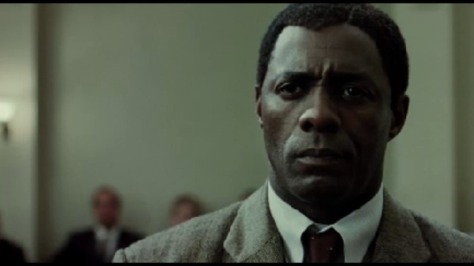TOO LITTE ATTENTION is paid to the screenwriters, many of whom manage to conjure up clear, credible stories out of vast tomes that dwell on the often un-filmable inner-life of people, and manage to contain it all within the two to three hour framework of a movie. And so this review pays homage to the English writer, William Nicholson whose craftsmanship has helped bring to life the magnificent “Gladiator”, Cate Blanchett’s “Elizabeth, the Golden Age” and (the risable) “First Knight”. It was his skill that was able to take Mandela’s biography (Mandela has been credited as one of the screen-writers) and fashion it, in “Mandela: Long Walk to Freedom”, into a taut, well acted, nicely directed and very human drama.
What could so easily have been a dramatized quasi-documentary history lesson is a fully-rounded, engagingly powerful story about a ‘born leader’. The story is about a man whose moral evolution segues from that of a flightily randy, self-absorbed striver (he was quite the ladies’ man) to a reluctant freedom-fighter, driven by anger and absorbed by the injustice of the system, to a man of peace and forgiveness dedicated to an almost impossible ideal of human togetherness.
Reviews have criticized the movie for being overly reverential, more about the icon than the man. I disagree – in “Mandela…” we meet someone who tries (and fails) to balance his role as a caring parent with that of a national leader. It was Shakespeare in the “Henry V” trilogy who first identified the inherent conflict between man as friend and father with man as leader and king. Henry V must shrug off the ‘humanity’ of his earlier incarnation as Prince Hal to become the august, and cold, leader of his fledgling nation. So too, we see, as Mandela’s life shifts from lover to leader that his world narrows away from the personal to the political. In the few moments when he was allowed to see his family (once every six months; and not until they were over sixteen), his conversations with Winnie and his daughter cannot stay away from what is his and, by extension, his family’s only reality: politics and the fight for freedom. One of the strengths of “Mandela…” is that, rather than glossing over the man and simply showing the icon, like “Henry V”, director Justin Chadwick (mainly TV stuff and “The Other Boleyn Girl”) and writer Nicholson allow us to see to extent to which Mandela must sacrifice the man, subvert his feelings, contain his anger, corral his sexual desires (when he’s finally re-united with a damaged, vengeance-driven Winnie) to become the icon of the great leader.
But this isn’t only Nelson’s long walk: the movie also clearly shows the tremendous role Winnie played – through violence and insurrection and guerilla tactics – in securing freedom and an equal vote. She too was incarcerated (for eighteen months in solitary) – an event that enabled her to channel her anger and fear into ruthless activism. Naomi Harris’ (Miss Moneypenny in “Skyfall”) “Winnie is a stunning (mini) portrait as we see her change over the years from the young blushing coquette to a stern, unbending revolutionary.
At the heart of the movie lies this dialogue between the role of insurrection v that of pacifism. At one moment, after years in prison, Mandela comes face to face with a group of younger prisoners, fellow-freedom fighters/seekers, who seethe with anger and for whom the icon of the struggle is just a bent, broken, passive old man tending his tomatoes in prison. What Mandela shows them is that all struggles progress and leadership lies in understanding how to respond to its phases. The movie (and probably the book, which I have not read) suggests that both forces – anger/resistance/terrorism as well as the force of forgiveness – are necessary. Winnie was as important as Nelson. His strength was in recognizing when it was necessary to change; together they brought South African freedom, but only his grander vision secured its future.
Idris Elba’s Mandela is a towering piece of acting. Though physically as an aged Mandela, he looks more like Sydney Poitier than Mandela, the actor manages to show a character criss-crossed by tensions, contradictions and restraint. He creates a Mandela as a man of action tempered by introspection and driven by almost super-human ideals.
Elba, or Idrissa Akuna Elba, (most people will recognize him from “Luther” and “The Wire”; along with other gems such as “Thor”, “Ghost Rider” and that modern classic, “Pacific Rim”), a Londoner of Sierra Leonese and Ghanian ancestry, is part of a wonderful flowering of extraordinary Black English talent. He joins Chiwetel Ejiofor (“12 Years a Slave”) – of Nigerian heritage; David Harewood ( as CIA director David Estes in “Homeland”) and Adrian Lester (recent OBE winner and lead in the National’s outstanding production of “Othello”), both of Caribbean heritage, to lead a renaissance of Black acting in the UK. Add to them Steve McQueen, who directed “12 Years…” and you feel there’s something very special occurring right now in England.




